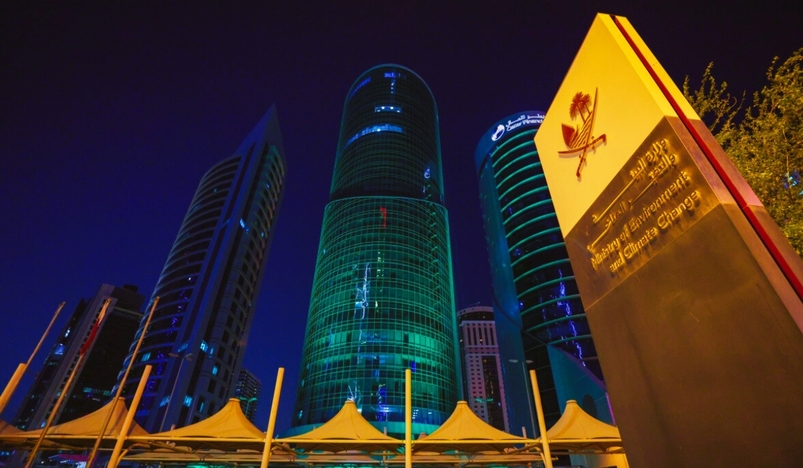
Doha, August 23 (QNA) - The Ministry of Environment and Climate Change (MECC), represented by the Natural Reserves Department, has issued its Q2 2025 report outlining its efforts in wildlife conservation, development of natural reserves, and enforcement of environmental violations.
The report addressed ways to enhance environmental awareness and community participation, as part of the ministry’s plans to achieve the goals of Qatar National Vision 2030.
It stated that the Wildlife Development Department recorded 218 sea turtle nests this season and released 3,287 hatchlings. The department also received 7 requests to visit Fuwairit Beach, designated for turtle nesting and protection.
In the field of plant wildlife development, the report noted that the department supplied and planted 2,835 trees and seedlings during May and June and fenced two Rawdas.
The department conducted 251 field visits to fenced Rawdas and designated planting sites, carried out 132 environmental impact assessments for development projects, removed 72 invasive Prosopis trees, issued 25 permits for activities in vegetation zones, and expanded Rawda areas outside reserves in 20 locations.
Regarding animal wildlife and border control, the report indicated that the department imported 24,634 live organisms and 1,301 items of products, derivatives, and taxidermy specimens.
Additionally, the Wildlife Development Department issued 149 falcon crossing documents, 618 CITES import certificates, 7 export certificates, and 136 re-export certificates. It also received 11 applications to register dangerous animals before the registration deadline in April.
On the Myna bird control project, the report stated that the department successfully captured 5,093 birds over three months as part of a plan to limit the spread of this environmentally challenging species, through 6 external missions and 37 events and meetings.
In terms of natural resources, crushers, and quarries, the report noted that the department received a request to establish a new quarry and another to relocate an existing one.
It renewed two permits for mobile crusher units and two for sand screening units. It also renewed and issued 79 permits for sand transport, conducted 216 site visits, and recorded 144 violations related to crushers and quarries.
The report stated that the department received 11 plant-related reports, 114 animal-related reports, 2 marine-related reports, and 61 reports concerning natural resources during Q2.
The Land Protection Department recorded 265 environmental violations, including 64 for unauthorized camps and farms, 30 for camel releases, 33 for littering, 4 for using bird-calling devices, 15 for dust generation due to uncovered trucks, 7 for unauthorized entry into Rawdas, 85 for unlicensed activities, 12 for soil excavation, and 6 for cutting wild trees.
The department organized 78 cleanup campaigns in Rawdas and wilderness areas and received 1,100 requests to refund winter camp security deposits.
Regarding marine protection, the report stated that the department conducted 3,404 hours of monitoring, including 3,316 daily field patrols, 68 hours of surprise inspections, and 20 hours of diving. It prepared 5 statistical studies and issued 829 marine visit reports, totaling 834 reports and statistics.
It recorded 148 violations, including the use of illegal tools affecting marine life, damage to coral reefs, use of banned nets and equipment, and fishing within reserves.
The teams confiscated 86 banned fishing nets, 11 long fishing lines, 25 fish traps, 6 lighting tools, and 2 violations involving illegal seabird hunting equipment.
The report noted that the department received a total of 36 requests, reports, and inquiries, including 17 requests to remove encroachments, 11 reports, 3 inquiry calls, and 5 service requests. Activities included 3 training workshops, 4 cleanup campaigns, 3 inspection campaigns, and 4 work meetings.
The Natural Reserves Department continued its efforts to develop and expand protected areas by improving infrastructure and enhancing environmental management.
The department developed an artificial hatchery for ostrich eggs and implemented 8 breeding and rehabilitation programs for endangered species such as the Arabian oryx and wild ostrich, supporting wildlife sustainability.
It also continued developing Al Shahaniya Reserve for wildlife breeding, worked on nominating Al Thakhira Reserve for UNESCO World Heritage status, prepared the development plan for Khor Al Udaid, and readied Bin Ghannam Island as part of environmental protection projects.
In the context of community partnership, the report highlighted a series of awareness lectures for various community groups, cleanup campaigns in land and marine areas, and numerous events and programs with wide participation from volunteers and local entities, reflecting the community’s role as a key partner in environmental conservation efforts.
The report showed that the department handled 227 environmental complaints, issued 85 permits for national development projects within reserve boundaries, processed 183 inquiries and complaints, and intensified field visits to Al Shahaniya and Al Thakhira reserves.
Source: QNA
.jpg)
Qatar Secures Place Among the World's Top 10 Wealthiest Nations
.jpg)
Hamad International Airport Witnesses Record Increase in Passenger Traffic

Saudi Arabia: Any visa holder can now perform Umrah

What are Qatar's Labour Laws on Annual Leave?
Leave a comment